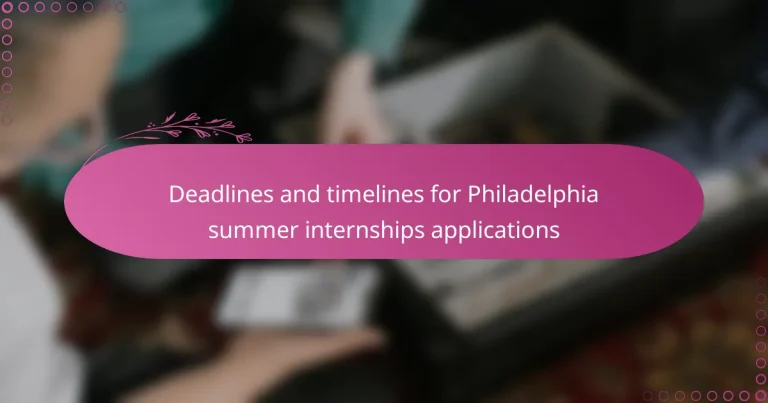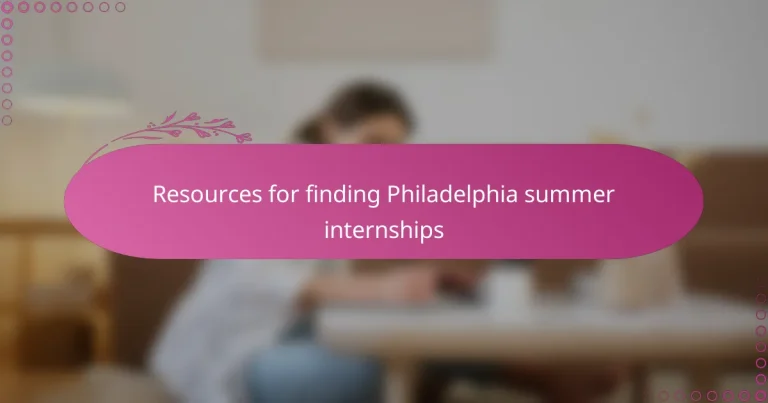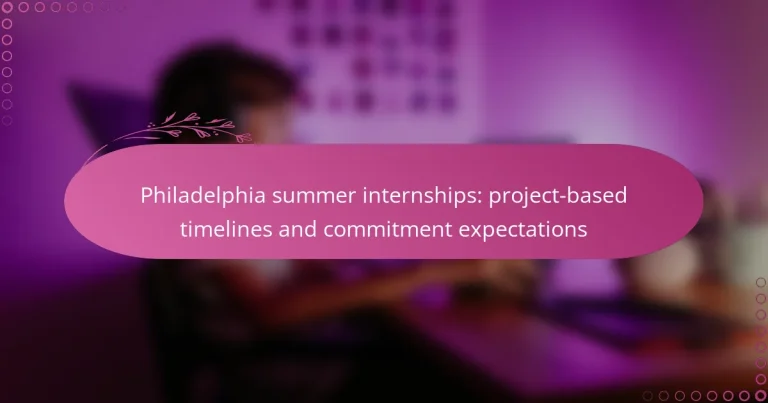

What are the key strategies for leveraging social media for summer internships in Philadelphia?
Utilizing social media effectively can enhance the search for summer internships in Philadelphia. First, create a professional profile on platforms like LinkedIn. Highlight relevant skills and experiences clearly. Next, engage with local companies by following and interacting with their pages. This increases visibility and demonstrates interest. Additionally, join local internship and job search groups on Facebook and LinkedIn. These groups often share exclusive opportunities. Regularly post about your internship search and share industry-related content. This establishes your presence in the field. Finally, network with alumni and professionals through social media. Personal connections can lead to internship referrals.
How can students identify internship opportunities through social media?
Students can identify internship opportunities through social media by utilizing platforms like LinkedIn, Facebook, and Twitter. These platforms host numerous job postings and internship announcements. Students should follow companies and organizations in their field of interest. Engaging with posts and joining relevant groups can increase visibility. Networking with professionals can lead to referrals and insider information. Using specific hashtags related to internships can help in discovering opportunities. Many companies post openings on their social media accounts before listing them elsewhere. Research indicates that 79% of job seekers use social media in their job search, highlighting its effectiveness.
What platforms are most effective for finding internships in Philadelphia?
LinkedIn, Handshake, Indeed, and Glassdoor are the most effective platforms for finding internships in Philadelphia. LinkedIn connects users with professionals and companies, facilitating internship searches. Handshake is specifically designed for college students, offering tailored internship listings. Indeed aggregates job postings, including internships, from various sources. Glassdoor provides insights into company cultures and internship experiences. These platforms collectively enhance visibility and access to internship opportunities in the city.
How can students utilize hashtags to discover relevant internship postings?
Students can utilize hashtags to discover relevant internship postings by searching for specific tags related to internships. Popular hashtags include #Internship, #InternshipOpportunities, and #InternshipsPhiladelphia. Students should also include their field of interest, such as #MarketingInternship or #EngineeringInternship. Using location-based hashtags like #PhiladelphiaInternships can narrow down opportunities. Engaging with posts under these hashtags can lead to discovering new listings. Many companies actively post internship opportunities using these hashtags, making them essential for job seekers. According to research by Jobvite, 79% of job seekers use social media in their job search, highlighting the effectiveness of hashtags.
What role does networking play in leveraging social media for internships?
Networking is crucial for leveraging social media for internships. It facilitates connections with industry professionals and peers. These connections can lead to internship opportunities through referrals. Research shows that 70% of jobs are found through networking. Social media platforms like LinkedIn enhance visibility and engagement. They allow users to showcase skills and experiences effectively. Engaging with relevant content can attract the attention of recruiters. Networking expands the reach of job searches beyond traditional methods.
How can students connect with industry professionals on social media?
Students can connect with industry professionals on social media by actively engaging on platforms like LinkedIn, Twitter, and Facebook. They should create a professional profile that highlights their skills and experiences. Joining industry-specific groups can facilitate networking opportunities. Students can follow companies and professionals in their field of interest. Engaging with posts through comments or shares can increase visibility. Sending personalized connection requests can lead to meaningful interactions. Participating in online discussions and webinars hosted by professionals can also enhance connections. Research shows that 85% of jobs are filled through networking, emphasizing the importance of these connections.
What are some best practices for engaging with potential employers online?
Engaging with potential employers online involves several best practices. First, maintain a professional online presence. This includes using a clear profile photo and a concise bio that highlights your skills. Second, actively participate in relevant industry discussions. Commenting on posts and sharing insightful content can showcase your knowledge. Third, personalize your outreach. When connecting with employers, send tailored messages that express genuine interest in their work. Fourth, follow companies of interest and engage with their content. Liking and sharing their posts can increase your visibility. Fifth, utilize LinkedIn effectively. Regularly update your profile and connect with industry professionals. Research indicates that 85% of jobs are filled through networking, emphasizing the importance of these practices.
How can students enhance their social media profiles to attract internship opportunities?
Students can enhance their social media profiles by showcasing relevant skills and experiences. They should update their profiles with a professional photo and a clear bio. Including keywords related to their field of interest is essential. Students should share industry-related content to demonstrate their knowledge. Engaging with professionals in their desired industry can expand their network. Additionally, students should highlight any projects or internships they have completed. Consistent activity on platforms like LinkedIn can increase visibility. A well-structured profile can attract potential employers looking for interns.
What elements should be included in a professional LinkedIn profile?
A professional LinkedIn profile should include a clear profile picture, a compelling headline, and a detailed summary. The profile picture should be professional and approachable. The headline should succinctly convey your current role or career aspirations. The summary should highlight your skills, experiences, and career goals.
Additionally, it should feature a comprehensive work experience section. This section must list relevant positions with specific achievements and responsibilities. Education details should also be included, showcasing degrees and institutions attended. Skills should be listed to reflect your expertise, and endorsements from connections can enhance credibility.
Finally, recommendations from colleagues or supervisors can provide social proof of your abilities. According to LinkedIn data, profiles with complete information receive 40 times more opportunities.
How can students use social media to showcase their skills and experiences?
Students can use social media to showcase their skills and experiences by creating professional profiles. They should highlight relevant achievements and projects on platforms like LinkedIn. Posting content related to their field demonstrates expertise and engagement. Sharing articles or insights shows knowledge and thought leadership. Engaging with industry professionals can expand their network. Participating in discussions enhances visibility and credibility. Using hashtags related to their skills increases discoverability. This approach can attract potential employers and internship opportunities.

What are the challenges of using social media for internship searches?
Using social media for internship searches presents several challenges. One major challenge is information overload. Users may encounter excessive posts and advertisements, making it difficult to find relevant opportunities. Additionally, the quality of information can vary significantly. Many posts may not provide accurate or complete details about internship positions.
Another challenge is the potential for unprofessional interactions. Candidates may face scrutiny from employers based on their social media profiles. Inappropriate content can negatively impact their chances of securing internships. Furthermore, networking through social media can be time-consuming. Building meaningful connections often requires significant effort and persistence.
Lastly, competition is fierce on social media platforms. Many candidates are vying for the same opportunities, making it challenging to stand out. These factors collectively complicate the process of using social media effectively for internship searches.
What common pitfalls should students avoid on social media?
Students should avoid oversharing personal information on social media. This can lead to privacy breaches and unwanted attention. They should also refrain from posting inappropriate content. Such posts can harm their professional image. Engaging in online arguments or negative comments can damage reputations. Employers often review social media profiles during hiring processes. A survey by CareerBuilder found that 70% of employers use social media to screen candidates. Additionally, students should avoid inconsistent branding across platforms. A cohesive online presence helps create a positive impression. Lastly, they should not ignore privacy settings. Proper settings can help control who sees their content.
How can students maintain professionalism while engaging on social media?
Students can maintain professionalism while engaging on social media by curating their online presence. They should use a professional profile picture and a clear bio that reflects their career aspirations. Students must avoid posting inappropriate content, including offensive language or images. They should engage in meaningful conversations relevant to their field of interest. Sharing industry-related articles and insights showcases their knowledge and interest. Additionally, students should connect with professionals and peers in their desired industry. Regularly updating privacy settings can help control who sees their content. Following these practices enhances their professional image and networking opportunities.
What are the risks of oversharing personal information online?
Oversharing personal information online can lead to various risks. These include identity theft, where criminals can use shared details to impersonate individuals. Cyberbullying may occur as oversharing can expose individuals to harassment. Privacy invasion is another risk, as personal data can be misused by others. Additionally, oversharing can affect professional opportunities, as employers may review social media profiles. According to a CareerBuilder survey, 70% of employers use social media to screen candidates. Lastly, oversharing may lead to unwanted attention or stalking, increasing personal safety concerns.
How can students stay organized while searching for internships on social media?
Students can stay organized while searching for internships on social media by creating a structured approach. First, they should establish specific goals for their internship search. This includes identifying desired roles and industries. Next, students can use spreadsheets or apps to track applications, deadlines, and contacts. They should categorize opportunities by platform, such as LinkedIn, Twitter, or Facebook. Regularly updating this information will help maintain focus and clarity. Additionally, students can set aside dedicated time each week for social media engagement. This ensures consistent networking and application efforts. According to a survey by NACE, 73% of students find internships through networking, highlighting the importance of organized outreach.
What tools can help track applications and communications with potential employers?
Applicant tracking systems (ATS) are tools that help track applications and communications with potential employers. These systems organize job applications and monitor interactions throughout the hiring process. Popular ATS options include Greenhouse, Lever, and Jobvite. They allow users to manage job postings, applications, and candidate communications in one platform. Many ATS also provide analytics to evaluate the effectiveness of recruitment efforts. According to a study by the National Association of Colleges and Employers, 75% of employers use ATS to filter candidates. This statistic highlights the importance of utilizing such tools in job applications.
How can students set goals to manage their social media internship search effectively?
Students can set specific, measurable, achievable, relevant, and time-bound (SMART) goals for their social media internship search. First, they should identify the type of internship they want. This could involve researching companies in Philadelphia that offer social media roles. Next, students should establish a timeline for their search. For example, they can set a goal to apply to five internships each week.
Additionally, they should optimize their social media profiles to reflect their skills and interests. This includes updating LinkedIn with relevant experiences and showcasing their work on platforms like Instagram or Twitter. Networking is crucial; students should aim to connect with industry professionals weekly.
Tracking progress is essential. Students can maintain a spreadsheet to monitor applications and follow-ups. Studies show that goal-setting increases motivation and accountability. By following these steps, students can effectively manage their internship search through social media.

What are some success stories of leveraging social media for internships in Philadelphia?
Many students in Philadelphia have successfully leveraged social media to secure internships. For instance, a recent Temple University graduate utilized LinkedIn to connect with local companies. This student engaged with industry professionals through posts and comments, showcasing their skills. As a result, they received multiple internship offers from companies in the Philadelphia area. Another example involves a Drexel University student who used Twitter to follow and interact with local startups. This proactive approach led to an internship with a well-known tech firm. These instances demonstrate the effectiveness of social media in facilitating internship opportunities in Philadelphia.
How have other students successfully secured internships through social media?
Students have successfully secured internships through social media by strategically networking and showcasing their skills. Many have utilized platforms like LinkedIn to connect with industry professionals. They often share relevant content to demonstrate their expertise. Students also engage in conversations within groups related to their fields. This active participation can lead to job referrals and internship opportunities.
Additionally, students have created professional profiles that highlight their experiences and projects. They often tag companies in their posts to increase visibility. Research indicates that 70% of employers use social media to screen candidates. This underlines the importance of maintaining a positive online presence. By effectively using social media, students can enhance their chances of landing internships.
What strategies did they employ that can be replicated?
They employed targeted social media campaigns to attract potential interns. These campaigns utilized specific hashtags related to Philadelphia internships. They also engaged with local universities and student organizations through social media. This approach increased visibility among the target audience. They shared success stories from past interns to build credibility. Regularly posting internship opportunities kept their audience informed. Collaborating with influencers helped to broaden their reach. Analytics were used to refine their strategies based on engagement metrics.
What lessons can be learned from their experiences?
Effective use of social media can enhance internship opportunities. Engaging with local organizations on platforms like LinkedIn increases visibility. Tailoring content to showcase skills and experiences attracts potential employers. Networking through social media can lead to referrals and insider information about openings. Consistent online presence builds a professional brand that resonates with recruiters. Participating in relevant online discussions demonstrates expertise and interest. Utilizing hashtags related to internships can improve searchability and reach. Analyzing successful case studies shows the impact of strategic social media use on securing internships.
What practical tips can students follow to maximize their social media internship search?
Students can maximize their social media internship search by actively engaging with relevant platforms. They should create a professional profile on LinkedIn, showcasing their skills and experiences. Networking is crucial; students should connect with industry professionals and join relevant groups. Regularly sharing insightful content can demonstrate expertise and interest in the field. Utilizing hashtags related to internships can enhance visibility in searches. Following companies of interest helps students stay updated on internship openings. Additionally, students should personalize their outreach messages when contacting potential employers. Research shows that 85% of jobs are filled through networking, highlighting its importance in the internship search.
How can students create a content calendar for their social media engagement?
Students can create a content calendar for their social media engagement by outlining their posting schedule. First, they should identify key dates relevant to their internship search, such as application deadlines and networking events. Next, they can decide on content themes, such as tips for interviews or industry insights.
Using a digital tool like Google Calendar or Trello can help in organizing these themes and dates visually. Students should allocate specific types of posts for each day, such as motivational quotes on Mondays and industry news on Wednesdays.
Regularly reviewing and adjusting the calendar based on engagement metrics will optimize their content strategy. This structured approach ensures consistent and relevant communication with their audience, enhancing their chances of securing internships.
What are the best times to post about internship availability or interests?
The best times to post about internship availability or interests are weekdays between 10 AM and 2 PM. Engagement rates on social media peak during these hours. Research shows that posts made during lunch breaks receive higher interaction. Additionally, early mornings around 8 AM also see good engagement as users check their feeds before starting their day. Posting on Wednesdays and Thursdays tends to yield better results than other days. These times align with typical work schedules, maximizing visibility among potential interns.
The main entity of this article is “social media” as it relates to “Philadelphia summer internships.” The article provides key strategies for leveraging social media platforms like LinkedIn, Facebook, and Twitter to identify and secure internship opportunities in Philadelphia. It discusses best practices for creating professional profiles, engaging with potential employers, utilizing hashtags, and networking with industry professionals. Additionally, the article highlights common pitfalls to avoid and offers practical tips for maximizing the internship search through organized social media engagement.





